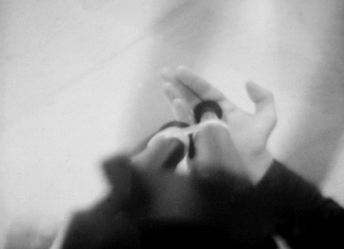“What is reality? There is no true reality or real reality. Reality is simply a more or less constant scanning pattern.” This statement from William Burroughs’ Nova Express, the third book of his Nova Trilogy, opens Dalibor Martinis’ (b. 1947) Image Is Virus, which its maker describes as follows: “If every picture is a virus, then television is an epidemic. This video presents an analysis of and commentary on the nature and the power of the televised picture. It consists of four parts, each bearing the name of one control function of a video-recorder: Slow-motion, Reset, Fast Forward, and Rewind."[3] Further to the opening quotation, the title of Image Is Virus is itself a reworking of the Burroughs sentence “Language is a virus,” found in The Ticket That Exploded, the second of the Nova Trilogy books. As Nada Beroš explains, “Since one image is worth a thousand words, Martinis draws the conclusion that TV is epidemic."[4]
According to Beroš, the video was made “at a time of very pronounced opposition to the mass media and their unremitting expansion,” and it focused specifically on television, exploring it as the kind of tool of mass mind control and addiction against which Burroughs’ surrealist criticism was directed. Image Is Virus’ critique was so timely, according to Beroš, that “the video . . . was considered obligatory viewing in many reviews and shows of video art in the eighties and won several prizes,” including one at the Seventh Tokyo Video Festival in 1984.[5] She further suggests that the influence of Burroughs on Martinis came not only in the form of general ideas; rather, it is evident also in the way Martinis “endeavours to visualize [Burroughs’] cut-up technique of writing. The Burroughs quotes run at the top of the images in the form of titles that follow the image by not following it,” creating a collage that borrows and juxtaposes bits and pieces from multiple sources much the way Burroughs’ writing did.[6]
Originally shot on U-matic and made at Meatball Productions in Holland, the video contains four parts titled after the standard buttons of a VCR recorder: Slow Motion, Reset, Fast Forward, and Rewind. Beroš describes the work as follows: “Each part begins with the eyes of a TV viewer fixed on us, the viewers of the viewer. The motif of observing the observer exists in several other Martinis video works, referring, among other things, to the role of video as a device for social control. Here it is used primarily for cutting between the individual units. Common to all parts is the stratification of the TV image—the elements of one small image are copied onto another image, turning it into its own ground. Slow Motion is a slow but constant movement up and down, like interference on the TV monitor, of an image that is falling. This part is shot in several public lifts, mainly in department stores, and it is the only unit that has some documentary interest, that relates to ‘real reality.’ In it the formal elements—collaged with Mondrianesque precision—have come particularly to the fore."[7]
In the second part, Reset, short excerpts of TV anchors saying, “Have a good evening,” at the bottom of TV newscasts are sequenced together, looped, and sped up so that they turn into one indistinguishable face uttering nonsense as “by zooming their images are pared down to practically the pixel level,"[8] thus profoundly disturbing both the visual and aural normalcy of the most standard TV programming.
“The third part, Fast Forward,” Beroš writes, “is built on a parallelism of shooting video-games and TV adverts. On the ground of a large blue square, with a sound track of shooting, TV commercials with shots of explosions, warplanes and destruction alternate. The eros of destruction and the destruction of eros are thus put into immediate propinquity without any direct commentary, while the title is followed by commands from a slot machine game: Pay it all, Pay it back, Play it back. . . . In the fourth part, Rewind, a little image grows into the background for a videogame, stretching over the whole screen. The close-up of a female face in a grimace of passion is accompanied by sounds of groans and sighs, sequences taken from a porn film. We are taken back to ‘reality’ by the rotation and inversion of the image that finally stabilizes as an initial sequence with eyes of the viewer of the screen of the receiver placed in some room from ‘real reality.’"[9] — Text adapted by Ksenya Gurshtein from a monograph by Nada Beroš
With thanks to Dalibor Martinis for his assistance with research and help in making a screening of this film possible in Washington.


